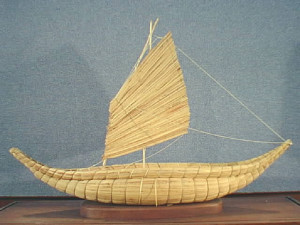Location: Upper Deck
The Ship
Our Ayamara model from Lake Titicaca is pretty much typical of balsa canoes worldwide. In Peru and Bolivia, the hulls are laid up of tortora reeds. In Africa, papyrus and in North America, of species Scirpus acutus or tule.
In early times variations of the balsa were common in equatorial and adjoining temperate regions in the Mediterranean, Nile drainage, Central Africa, the Middle East, and west coasts of North and South America from Chile to Northern California.
The Ayamara model is akin to archaeologically recovered Moche ceramic portrayals dating to 2,000 B.C., while Egyptian tombs have produced examples that range back at least another 1,000 years in time.
Balsa canoes are generally paddled or poled. However, the Ayamara employed tortora mat sails supported by a bipod mast similar to early Egyptian rigs or those of the Filipinos. Balsa canoes still are in use in Iraq, on Sardinia, at Africa’s Lake Chad, and in diminishing numbers on Lake Titicaca.
The local Chumash Indian tribes also used balsa canoes at one time, but they added their own refinement. They used the heavy black oil from the seeps in the floor of the Santa Barbara Channel to coat the hulls. This reduced water absorption and smoothed the hulls and made them faster. Early Spanish explorers noted the “black balsa” in their journals.
The Model
Scale: 1” H 35” L 45 ½” W 15”
Built by native craftsman. From the Quester Maritime Collection, Stonington, Connecticut.

